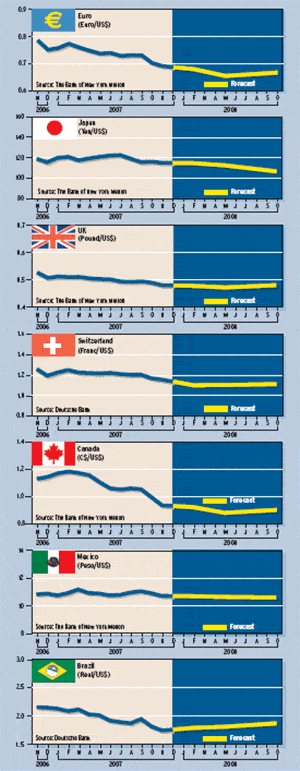FOREIGN EXCHANGE
Interest rate differentials are squeezing the last bit of life out of the dollar amid ongoing concerns about the health of the US financial system, analysts say.

“We think the ECB has finished its tightening cycle and that the current tightness caused by the credit markets and the strength of the euro will help to slow the eurozone economy,” Chandler says. Meanwhile, the US economy could begin to stabilize early next year, he says, and the dollar could begin to do better by the end of the first quarter of 2008 or early in the second quarter.
The key factors that investors should monitor in the weeks and months ahead are the health of the US financial system, the pace of decline in the housing sector and risks to the US economy, according to Chandler. There are large amounts of adjustable-rate mortgages that need to be reset, and the full extent of the impact of collateralized debt obligations on the balance sheets of financial services companies is not fully known.
“Every end of the housing cycle in the US has coincided with the end of the business cycle,” Chandler says. “The key issue is whether this cycle could be different.” The evidence to date suggests that the effects of the housing-market recession have been limited to related industries, he says. Other sectors, such as exports and consumer spending, are countering the weakness. “The US consumer has served as ballast for the economy, encouraged by job and income growth,” he says.
Meanwhile, the argument that further rate cuts would endanger the inflationary repercussions of a weak dollar does not appear to be holding up, says Ashraf Laidi, chief foreign exchange analyst at CMC Markets US in New York. US trade partners have been reluctant to raise prices in the face of an already weak US import demand and a falling dollar, he says.
Due to the fact that core inflation rates have been well behaved, and the risk of exacerbating fresh turmoil in capital markets, the Fed cannot afford to keep rates on hold, Laidi says. The lingering credit-market threat and the impending threat of faster erosion in the housing market and prolonged layoffs beyond the housing and finance industries could bring further rate cuts, he says.
Despite the stronger-than-expected US employment data for October, with a 166,000 increase in non-farm payrolls, it is premature to rule out a December rate cut, according to Laidi. While the immediate risks of a US recession have been averted, the erosion has been extended in construction, retail and manufacturing jobs, he says. Construction jobs declined for the fourth straight month in October.
Currency markets shrugged off the strong US payrolls and sent the dollar to fresh lows across the board, with the exception of the Japanese yen, as risk appetite returned to the market. A potentially weak holiday shopping season and weak third-quarter US corporate earnings are good reasons to be cautious, Laidi says.
David Gilmore, economist and partner at Essex, Connecticut-based Foreign Exchange Analytics, says he cannot recall any recent period during which senior US administration officials were so nonchalant about the decline of the dollar. “My concern is that the run-up in oil, gold, base metals, some grains and other precious metals reflects in part a hedge against an even weaker dollar,” he says.
These are not times for vice president Dick Cheney or anyone in or around the White House to applaud market pricing of the dollar without inviting additional selling, according to Gilmore. Cheney says the market is doing exactly what it should do in terms of setting the value of the dollar by reflecting fundamentals and adjusting in an orderly fashion.
The new conundrum facing the Fed will be far more significant slowing than the monetary authorities are imagining and a far greater need to ease, leaving the dollar extremely vulnerable, Gilmore says. “Strong-dollar credentials are in tatters, the US still depends on huge foreign-capital inflows and the need for very accommodative policy,” he says. “The Fed is going to need a much more credible Bush strong-dollar policy to lean on when the going gets tough for the US economy in 2008,” he says.
A steep falloff in US import growth, while export growth has remained at about its average rate for the past few years, has resulted in significant improvement in the US trade deficit, according to analysts at Deutsche Bank. Since September 2006, the deficit has narrowed by $107 billion, from $811 billion at its widest point to $704 billion by August this year.
“In our view, much if not all of the improvement in the US trade balance so far can be attributed to the growth rotation [away from the US to the rest of the world] that has taken place, rather than to the effects of the cheaper dollar,” Deutsche Bank says in a recent report. This is somewhat surprising in light of the large depreciation of the dollar, which should have boosted export volumes, and the significant increase in oil prices, which increased the import bill, the Deutsche Bank analysts say.
Historically, a necessary condition for above-trend export volume growth has been a dollar trading below fair value, which in turn has stimulated exports with a lag of six to eight quarters, the Deutsche Bank analysts say. They estimate that the dollar reached fair value in the third quarter of 2006, or five quarters ago. The lagged effects of the weaker dollar on export volumes should, therefore, be set to kick in right about now, they say.
The US trade gap narrowed in September despite record prices for imported oil. The high oil prices dampened demand for crude. The deficit shrank to $56.45 billion from $56.8 billion in August, as exports rose 1.1% to $140.15 billion, while imports rose 0.6% to $196.6 billion. Most economists had forecast a widening in the September trade deficit.
Gordon Platt



